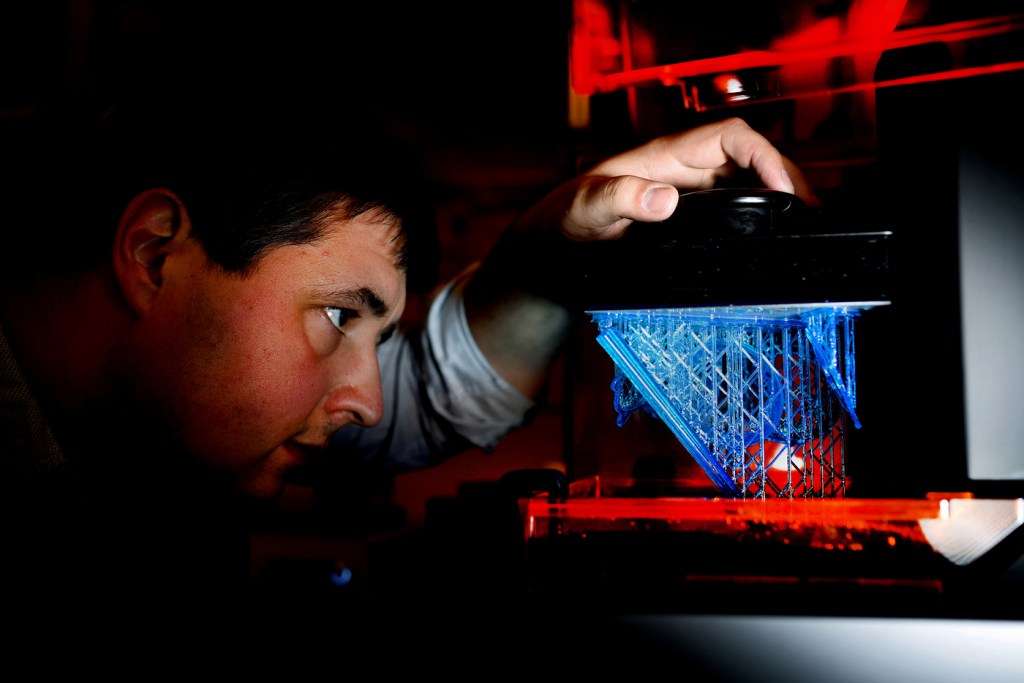How to bring 3-D printing into your teaching, research

There’s so much more to 3-D printing than making miniature husky statues for your office or creating other trinkets as gifts or Halloween costume accessories—although that’s still pretty neat. The technology can also pay huge dividends for faculty members in their classroom instruction and research.
In April at TEXPO, Information Technology Services’ third annual Teaching and Technology Expo, faculty members shared how they and their colleagues are incorporating 3-D printing into teaching and learning. Mark Sivak, who leads the 3-D Printing Studio in Snell Library, led the discussion, providing an overview of how faculty can take advantage of the studio—which offers a full suite of 3-D fabrication and modeling technologies.
“We have worked with every college, with projects ranging from creating 3-D versions of early Christian poems to the more hard sciences and engineering,” said Sivak, associate teaching professor in the Department of Art + Design and the College of Engineering. “There’s a lot of cool stuff you can do with this technology, and it’s here to stay.”
Sivak mentioned one project in which he collaborated with Sara Williams, now a doctoral student in professor Mark Patterson’s lab at the Marine Science Center. Williams—who was a research technician in the lab at the time—studies coral physiology. For her research, she designed a custom propeller for their flume, a long aquarium with one-directional water flow that’s used for studying the effects of fluid mechanics on marine organisms.

3-D printed custom propeller
“I had to have a specifically sized propeller, and was unable to find any online. I decided to give 3-D printing a try and design a custom propeller to fit in the flume,” Williams said. “This project was an excellent learning experience, and I loved being able to use Northeastern resources to build my own solutions for specific part requirements in my research.”
Also at TEXPO, Jennifer Love, assistant academic specialist in the College of Engineering, explained how she and other faculty utilize 3-D printing and other technologies in the First Year Engineering Learning Center. She described how she has challenged her students to create a better version of mousetrap car kits used in high school physics classes. One of the student teams designed an alternative energy vehicle kit for which they used the 3D printing studio’s laser printing technology.
What to know about the 3-D Printing Studio
The 3-D Printing Studio features 10 printers and offers four different types of 3-D printing technology as well as laser cutting and other resources. The average cost of a project is between $10 and $15, though the cost can vary widely; Sivak said some research projects, for instance, could cost more than $100.
There’s a lot of cool stuff you can do with this technology, and it’s here to stay.
Mark Sivak
Leader of the 3-D Printing Studio
Sivak is often invited by faculty members to deliver guest lectures on the process and benefits of 3-D printing. He also hosts small groups and classes for tours of the 3-D Printing Studio.
Before moving forward with a project, he suggested that first-time users schedule a consultation to learn about the technology available, receive help or advice with building a 3-D model, and understand how the whole process works from start to finish.
Once a project is submitted, the studio can turn around 3-D printed objects in one to three days, but faculty and students should expect the process to take between five and seven days. Sivak added that the studio gets much busier during midterms and finals.
Academic Technology Services also noted that there are a few different software options for students and faculty who would like to do 3-D printing work. Lynda.com has online tutorials for at least three of the most common tools used for this purpose: Learning 3-D Printing, SolidWorks 2017 Essential Training, and Rhino 5 Essential Training.





